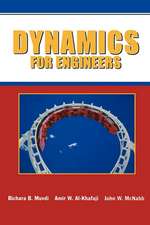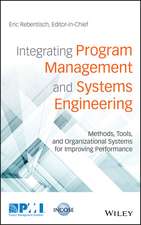Statics for Engineers
Autor Bichara B. Muvdi, Amir W. Al-Khafaji, John W. McNabben Limba Engleză Hardback – 25 iun 1997
| Toate formatele și edițiile | Preț | Express |
|---|---|---|
| Paperback (1) | 630.20 lei 38-44 zile | |
| Springer – 18 apr 2013 | 630.20 lei 38-44 zile | |
| Hardback (1) | 686.86 lei 43-57 zile | |
| Springer – 25 iun 1997 | 686.86 lei 43-57 zile |
Preț: 686.86 lei
Preț vechi: 808.07 lei
-15% Nou
Puncte Express: 1030
Preț estimativ în valută:
131.43€ • 137.57$ • 109.39£
131.43€ • 137.57$ • 109.39£
Carte tipărită la comandă
Livrare economică 31 martie-14 aprilie
Preluare comenzi: 021 569.72.76
Specificații
ISBN-13: 9780387947792
ISBN-10: 0387947795
Pagini: 912
Ilustrații: XVIII, 912 p. In 2 volumes, not available separately.
Dimensiuni: 178 x 254 x 51 mm
Greutate: 1.71 kg
Ediția:1997
Editura: Springer
Colecția Springer
Locul publicării:New York, NY, United States
ISBN-10: 0387947795
Pagini: 912
Ilustrații: XVIII, 912 p. In 2 volumes, not available separately.
Dimensiuni: 178 x 254 x 51 mm
Greutate: 1.71 kg
Ediția:1997
Editura: Springer
Colecția Springer
Locul publicării:New York, NY, United States
Public țintă
GraduateDescriere
This is the first volume of a comprehensive two-volume treatment of mechanics intended for students of civil and mechanical engineering. Used for several years in courses at Bradley University, the text presents statics in a clear and straightforward way and emphasizes problem solving. More than 350 examples clarify the discussion. The diskette included with the book contains EnSolve, a program written by the authors for solving problems in engineering mechanics. The program runs on Macintosh and PC-DOS computers and includes the following: - a unit converter for SI to US units and vice versa - a graphics program for plotting functions and data - a set of numerical subroutines The graphics module will, among other features, fit smooth splines between data, plot regression lines and curves, and change scales -- including from arithmetic to log and log-log. The numerical routines will, for example, find roots of polynomials, solve systems of equations, invert matrices, differentiate and integrate, and solve boundary-value problems.
Cuprins
1 Introductory Principles.- 1.1 Review of Mechanics.- 1.2 Idealizations and Mathematical Models.- 1.3 Newton’s Laws.- 1.4 Newton’s Law of Universal Gravitation.- 1.5 Systems of Units and Conversion Factors.- 1.6 Dimensional Analysis.- 1.7 Problem Solving Techniques.- 1.8 Accuracy of Data and Solutions.- 2 Equilibrium of a Particle in Two Dimensions.- 2.1 Scalar and Vector Quantities.- 2.2 Elementary Vector Operations.- 2.3 Force Expressed in Vector Form.- 2.4 Addition of Forces Using Rectangular Components.- 2.5 Supports and Connections.- 2.6 The Free-Body Diagram.- 2.7 Equilibrium Conditions and Applications.- 3 Equilibrium of Particles in Three Dimensions.- 3.1 Force in Terms of Rectangular Components.- 3.2 Force in Terms of Magnitude and Unit Vector.- 3.3 Dot (Scalar) Product.- 3.4 Addition of Forces Using Rectangular Components.- 3.5 Equilibrium Conditions and Applications.- 4 Equilibrium of Rigid Bodies in Two Dimensions.- 4.1 Concept of the Moment-Scalar Approach.- 4.2 Internal and External Forces—Force Transmissibility Principle.- 4.3 Replacement of a Single Force by a Force and a Couple.- 4.4 Replacement of a Force System by a Force and a Couple.- 4.5 Replacement of a Force System by a Single Force.- 4.6 Replacement of a Distributed Force System by a Single Force.- 4.7 Supports and Connections.- 4.8 The Free-Body Diagram.- 4.9 Equilibrium Conditions and Applications.- 5 Equilibrium of Rigid Bodies in Three Dimensions.- 5.1 Definition of the Cross (Vector) Product.- 5.2 The Cross-Product in Terms of Rectangular Components.- 5.3 Vector Representation of the Moment of a Force.- 5.4 Varignon’s Theorem.- 5.5 Moment of a Force About a Specific Axis.- 5.6 Vector Representation of a Couple.- 5.7 Replacement of a Single Force by a Force and a Couple.- 5.8 Replacement of a General Force System by a Force and a Couple.- 5.9 Equilibrium Conditions and Applications.- 5.10 Determinacy and Constraints.- 6 Truss Analysis.- 6.1 Analysis of Simple Trusses.- 6.2 Member Forces Using the Method of Joints.- 6.3 Members Carrying No Forces.- 6.4 Member Forces Using the Method of Sections.- 6.5* Determinacy and Constraints.- 6.6 Compound Trusses.- 6.7* Three-Dimensional Trusses: Member Forces Using the Method of Joints.- 7 Frames and Machines.- 7.1 Multiforce Members.- 7.2 Frame Analysis.- 7.3 Machine Analysis.- 8 Internal Forces in Members.- 8.1 Internal Forces.- 8.2 Sign Conventions.- 8.3 Axial Force and Torque Diagrams.- 8.4 Shear and Moment at Specified Cross-Sections.- 8.5 Shear and Moment Equations.- 8.6 Load, Shear, and Moment Relationships.- 8.7 Shear and Moment Diagrams.- 8.8* Cables Under Concentrated Loads.- 8.9* General Cable Theorem.- 8.10* Cables Under Uniform Loads.- 8.11 Frames—Internal Forces at Specified Sections.- 8.12 Internal Force Diagrams for Two-Dimensional Frames.- 9 Friction.- 9.1 Nature and Characteristics of Dry Friction.- 9.2 Angles of Static and Kinetic Friction.- 9.3 Applications of the Fundamental Equations.- 9.4 The Six Fundamental Machines.- 9.5* Friction on V-Belts and Flat Belts.- 9.6* Friction on Pivot and Collar Bearings and Disks.- 9.7* Friction on Journal Bearings.- 9.8 Problems in Which Motion Is Not Predetermined.- 10 Centers of Gravity, Centers of Mass, and Centroids.- 10.1 Centers of Gravity and of Mass.- 10.2 Centroid of Volume, Area, or Line.- 10.3 Composite Objects.- 10.4 Centroids by Integration.- 10.5* Theorems of Pappus and Guldinus.- 10.6* Fluid Statics.- 11 Moments and Products of Inertia.- 11.1 Concepts and Definitions.- 11.2 Parallel-Axis Theorems.- 11.3 Moments of Inertia by Integration.- 11.4 Moments of Inertia of Composite Areas and Masses.- 11.5* Area Product of Inertia.- 11.6* Area Principal Axes and Principal Moments of Inertia.- 11.7* Mohr’s Circle for Area Moments and Products of Inertia.- 11.8* Mass Principal Axes and Principal Moments of Inertia.- 12 Virtual Work and Stationary Potential Energy.- 12.1 Differential Work of a Force.- 12.2 Differential Work of a Couple.- 12.3 The Concept of Finite Work.- 12.4 The Concept of Virtual Work.- 12.5* Work of Conservative Forces.- 12.6* The Concept of Potential Energy.- 12.7* The Principle of Stationary Potential Energy.- 12.8* States of Equilibrium.- Appendix A. Properties of Selected Lines and Areas.- Appendix B. Properties of Selected Masses.- Appendix C. Useful Mathematical Relations.- Appendix D. Selected Derivatives.- Appendix E. Selected Integrals.- Appendix F. Supports and Connections.- Appendices.- Answers.










